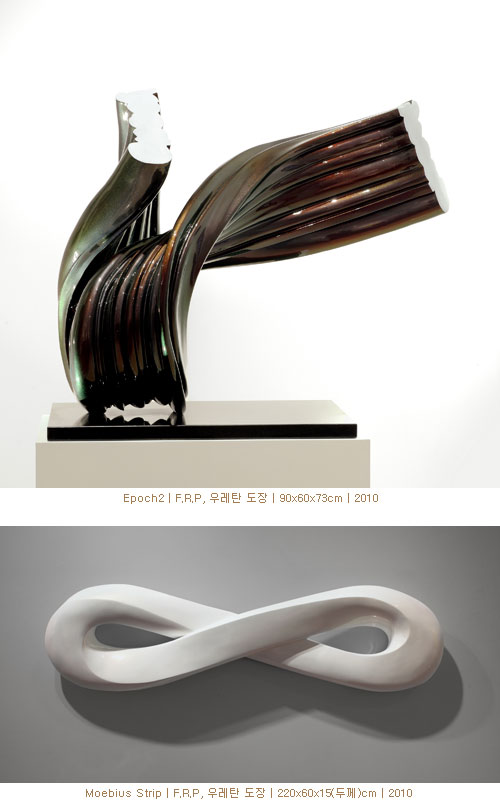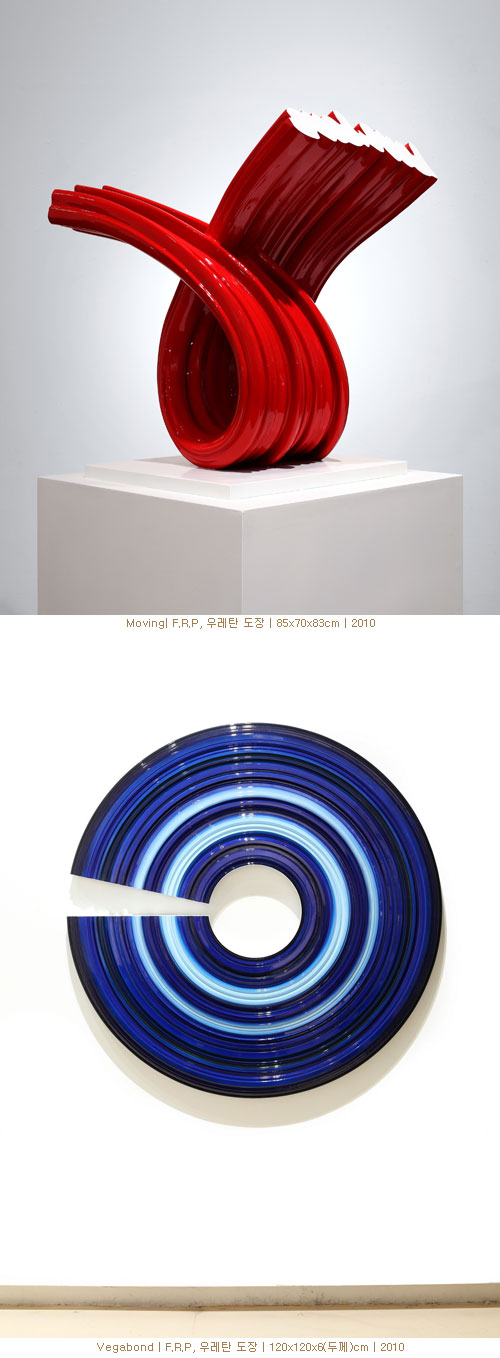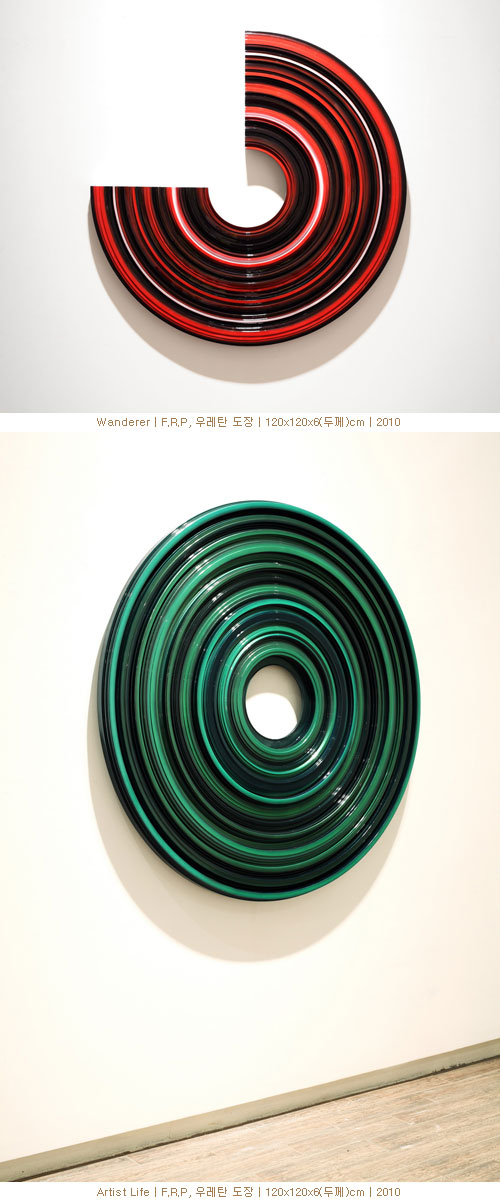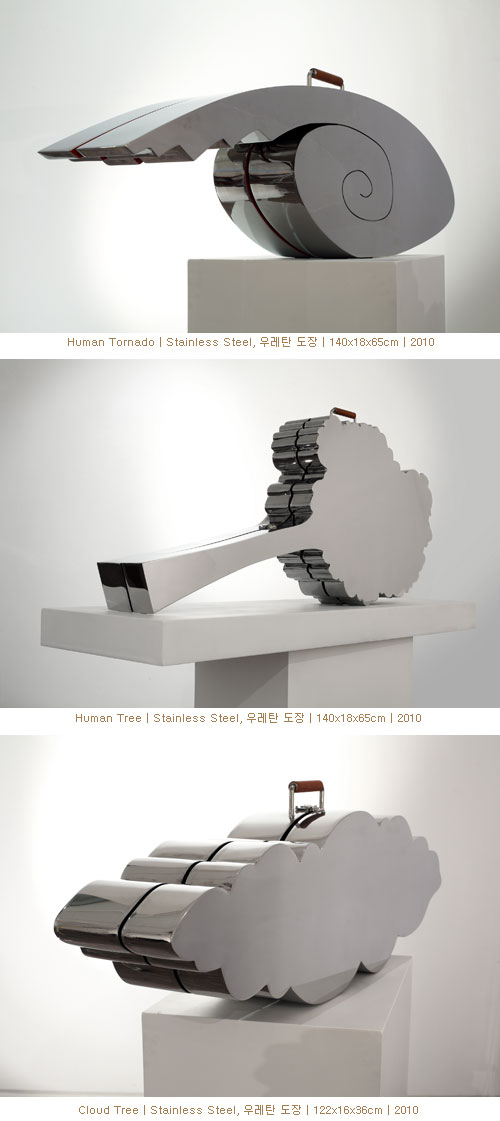상세정보
일상의 감각을 채집하고 그것들의 충돌 혹은 엮임 등 새로이 조합된 감각들을 사유하는 작업
〈Floating Epoch〉-김건주 전최흥철 | 독립 큐레이터
검은 비닐 LP 레코드 음반은 대표적인 올드 미디어 중 하나이다. 이따금 색이 바래가는 낡은 종이 자켓과 기름종이에서 이것을 꺼낸 다음 회전하는 동심원을 따라 섬세하게 깍아서 새긴 주름같은 골을 바라보고 있으면 귓가에는 어느덧 친숙한 멜로디가 재현됨과 동시에 뇌리에는 노랫말을 떠올릴 수 있다. 우리는 물리적인 실체를 탈피한 이미지를 결로 간주하고 있고 다수의 겹쳐진 결에서 단층과 흡사한 주름을 떠올릴 수 있을 것이다. 그러하듯이 침잠해 있던 이미지들이 어렴풋이 떠오르는 순간을 잡아내기 위하여 스폰지, 고무, 스티로폼 등, 말랑말랑한 느낌의 재료에 잡아내고 멀티 감각을 동원하여 또렷하게끔 만드는 김건주의 중의적인 의미와 형태의 조각들은 그래서 이 레코드 판과 공감각적인 면에서, 그리고 부드럽게 휘어진 주름의 결에서 닮아 보인다. 사실 조각이라는 매체는 이미지를 포착하기에는 어울리지 않다. 시적 느낌과 유연함을 선호하는 작가의 개성은 정형성이 강한 조각과 조형적으로 경직된 작업의 거북함에 대한 반작용으로 우연성을 강조하고 반형태적이며 소재를 소박하게 드러내는 부드러운 조각(soft sculpture)을 선호하는 경향이 두드러진다.
〈Floating Epoch, 떠도는 시대〉라 명명한 2010년의 전시는 보다 다층적인 의미와 이미지의 조합을 보여주었던 이전의 〈Collection of Senses(2009)〉전, 또는 마치 단편적인 가공의 이야기들을 모아놓은 신화와도 같이 작가의 소소할 수도 있는 삶의 에피소드들을 모은 것이 그의 전시라는 〈Myth, 신화(2007)〉전의 일련의 흐름을 여전히 이어오고 있다. 마찬가지로 이번 전시에서의 작품들이 각각 코드화된 기표(signfiant)들이 기의(signifie)와의 관계성을 넘어서고, 지시하는 낱말(ex. 구름, 방랑, 삶, 경이로운, 토네이도, 시대, 흘러가는, 움직임, 예술가, 나무 등)들이 서로 연결되어서 결국 한 편의 운문처럼 전체적인 맥락을 조합해내고 있음을 파악하게 되면 비로소 김건주 작업의 중요한 면모인 문예감(文藝感)과 첫 대면할 수 있을 것이다. 그렇지만 딱딱한 엄숙주의에 치우치지 않도록 적절한 단어-의 실루엣-를 선택하고 이것을 카툰 스타일의 의성어(ex. BANG)나 의태어(ex. CRASH)처럼 만화 지문의 형태로 변형하여 서브컬처의 적절한 가벼움과 함께 시각적 즐거움을 누리게 한다.

또한 그의 작품들 역시 다양성은 여전하나 한결 심플하게 정리되어가는 방향으로 정립되고 있다. 이전 전시의 작업들은 특히 소재와 형식을 따로 보면 한 공간에서 직접적인 시각적인 충돌을 야기하는 의도를 굳이 감추지 않았다. 예를 들자면, 중량을 벗어나는 구름 같은 느낌을 위해 젯소를 단면 부분에 바른 스펀지로 만든 이미지 형태들의 말랑한 꾸러미를 매다는 설치 작업과 동시에 이와는 대조적으로 뚜렷하게 구상화시킨 이미지 혹은 단어를 합성수지와 같은 단단한 소재에 경화시키는 시각 요소 중심의 작품들이 공존하는 식이었다. 그러나 이 전시의 입체 작업들은 비록 부드러운 형태를 유지하고 있지만 화공적인 견고한 재료로 만들어간다는 면에서 보다 전통적인 조각에 가까우며 표면의 고광택 채색의 공업생산품적인 느낌은 무엇보다도 C. 브랑쿠시(1876-1957)의 조각의 표면과 관련해서 생각해 볼 수 있다.
그는 우선 자신의 주변에서 발생과 원인이 각각인 소소한 일상에 보다 주목한다. 이렇게 그가 조우한 극적인 사건, 상황, 떠올린 단어, 그리고 사물의 이미지들은 그의 사방에서 부유하고 있으면서 차례대로 관계 맺기를 기다리고 있다. 하지만 대개의 수집광들이 그들의 수집품들을 진열할 때 그러하듯 비록 다른 사람들은 쉽게 알아보긴 힘들지만 오롯이 자신만은 카오스에 버금갈 만큼 어지러움 가운데서도 쉽게 알아볼 수 있도록 진열의 순서와 배치를 결정하는 은밀한 비밀이 있기 마련이다. 설치 작품 ‘떠도는 것들’(2007, 2010)에서 우리는 중력에 최대한 저항하듯 둥둥 부유하는 한 순간의 이미지들을 포착하거나 수집하기 위한 유용한 방법으로써 그가 우선 사물이나 개념의 대표적인 시각요소인 형태 외관(shape)의 인상에 집중함을 발견할 수 있다. 그는 보다 직접적인 표현을 선호한다. 그리고 사적인 기억이나 사회적 의미의 맥락에서 채집된 이미지와 기호들을 큰 묶음으로 모을 수 있도록 먼저 관계 맺기를 위한 일종의 규칙을 정한다. 가령 그것은 작가가 처한 상황과 관련해서 부각되는 주제를 중심으로 정리하는 것이거나 안과 밖, 또는 빛과 어두움처럼 양극단으로 이미지들이 마구 부딪히게 할 수도 있다. 백화 만발한 심상의 정원이 있어서, 거기에서 내키는 대로 뽑은 이미지를 마구 융합해서 이종(異種)의 것들을 실험할 수도 있음은 물론이다. 그렇지만 수없이 교차로 겹쳐진 원자기호를 연상케 하는 작품 ‘On the Road’가 지시하듯이 그 모든 것들은 결국 작가라는 핵을 중심으로 떠도는 것들이고 작가 자신을 대리하는 것이다.

그리고 앞에서 언급한 이전 전시들과의 연관성을 대조해보면 한 회의 전시에만 국한 된 것이 아니라는 것을 알 수 있다. 과거부터 현재에 이르기까지의 모든 작품은 기호화된 언어로써 다시 한 번 한 연의 시구처럼 연쇄적으로 연결된다. 그러므로 얽힌 관계성에 대해 쉬지 않고 달려 온 작가의 모든 작품 활동은 전체적으로, 또 유기 화합물의 구조처럼 앞 뒤의 시간들이 사슬처럼 순환하면서 잇대어져 성장해가는 자전적 술어임을 눈치챌 수 있다. 이런 맞물린 순환은 금속 케이스 형태가 내부의 공허한 이미지를 담고 있어서 껍질이자 씨앗이 있었던 자리라는 아이러니한 개념의 가방 연작 작업에서도 드러난다. 따라서 맥락의 변화 과정에서 분리한 개별의 작품들은 철학적 의미에서 에포케(epoche), 즉 일단 판단을 보류한 상태로 간주하여야 한다. 여기서 작가가 단어를 선택하는 것과 기호를 사용하는 것은 일맥상통하다는 점을 염두에 둔다면, 유시유종의 의미가 무색하게도 무한 순환이 반복되는 뫼비우스의 띠를 선택한 의도를 이해할 수 있다. 게다가 기호의 이미지는 조각과 결합하여 이종 이미지로써 구체적인 형태를 강화하고 있음도 물론이다.
그는 부드럽게 굴곡진 주름이 인상적인 그의 신작 ‘Artist’을 빌어서 예술가의 의미를 묻는, 존재론으로 환원될 수도 있는 질문을 거듭 던지는 듯하다. 물질적이든 관념적이든 지극히 본질적인 차원의 이와 같은 자문자답하는 우문의 순환은 결코 생각하는 갈대인 작가가 나름의 답을 제시하기 위함이 아님은 명백하다. 삶(그리고 현실)에 대한 질문과 답, 그것들에 대한 작가 스스로의 즉각적인 반응이 이 전시의 가장 큰 맥락을 형성할 것이다. 하지만 존재를 중심에 두고 외부와 타자의 시선에서 자유롭고자 하는 예술가로서의 삶에 다시 한 번 의문을 품음으로 해서 오히려 그가 또 다른 단계로의 도달을 자각하고 있음을 암시하고 있다. 곤충이 우화를 위해 탈피한 후 껍질이 단단해지는 것에 비유하자면 예술가로써 거듭 단련되었음을 말이다. 그래서 이 작품은 ‘On the Road’와 마찬가지로 새로운 전시의 의도하는 바를 직설적으로 보여주면서, 동시에 살짝 반짝이게 백색으로 채색된 깊은 주름의 다발이 크게 한 번 뒤집어 꼬아 만든 무한 매듭의 전체 형태로 전시 공간의 중심을 배꼽마냥 잡아주고 있다. 모체에 이어졌던 탯줄의 혈류를 끊고 뒤집어 맺음한 움직일 수 없는 증거인 배꼽이야 말로 인체 중 뫼비우스의 띠와 가장 닮았지 않은가?
 Floating Epoch : Kim Geon-ju’s Exhibition
Floating Epoch : Kim Geon-ju’s ExhibitionBy Choi Heung-cheol , Independent Curator
Black vinyl LP records are one of the oldest types of media. After taking a record out of its old discolored paper cover and sleeve, and looking at the grooves etched onto its surface, I find myself begin to remember the lyrics of its songs whilst their melodies plays along in my thoughts. We consider images devoid of physical substance layers of texture, and often come to recall fault-like folds from multiple layers of images. In this way, Kim Geon-ju’s sculpture, with its ambivalent meanings and forms, has a similarity to records, in terms of their multisensory characteristics and smoothly warped folds, where he uses cushiony materials such as sponge, rubber, and styrofoam to capture fleeting fragments of images stuck deep inside the brain, making them clear with a type of synesthesia. It is true that sculpture is not the most effective medium in visual art for capturing images. Nevertheless, Kim, with his preference toward poetic descriptions and suppleness, tends to highlight contingency and a soft sculpture that reveals its own materiality as plainly as possible, with no insistence of form itself. This is probably due to his discomfort toward existing tendencies in sculpture that stress conventionally readable forms.
The upcoming 2010 exhibition, entitled Floating Epoch, is in line with his earlier shows—such as 2009’s Collection of Senses, which combined multilayered meanings and images, and 2007’s Myth—thereby giving an impression that his exhibition is a collection of seemingly trivial episodes in life as if they were a myth, made up of collected fragments of made-up stories. Along with this, you may come across important facets of Kim’s ‘literary nature’, through an understanding of the overall poetic context from each isolated word (clouds, wandering, life, marvelous, tornado, epoch, flowing, movement, artist, tree etc), and the departure of his works from the relation between the signifier (signifiant) and the signified (signifié). Choosing his own graphic language—the silhouette—which is free from rigidity, and transforming it into cartoon expressions like ‘BANG’ or ‘CRASH’, Kim encourages the viewer to be amused by their visual play, in addition to their use of the appropriately light humor of sub-culture.

It is also significant that Kim’s work is notable for its brevity as well as its usual diversity. The previous exhibition did not hide his intention of visual confronting to the viewer’s experience. For instance, there was a hanging installation of soft lumps made out of gesso-painted sponges, creating the ambiances of clouds resisting gravity, whilst at the same time being solid works for clearly figurative images. In contrast to this, more recent pieces may be related to the surfaces of Brancusi’s work—particularly due to their use of highly polished industrial materials—and their relationship to traditional sculpture, as despite their soft forms, they were made of solid chemical materials.
Kim gives his attention to the commonplace happenings in our daily lives—everyday events with all kinds of causes. He depicts his own experience of encounters using images of dramatic situations, incidents, things and words that have risen up into his consciousness, and they all float around his surroundings, waiting to find their connection with one another. There is a relationship perhaps with the way that most collectors skillfully manage their collections with schemes of order and methods of display, keeping chaos and confusion at bay, with a sense of secret knowledge in their systems that others can’t catch. In his installation entitled Floating Stuffs (2007, 2010), we may find that Kim stresses the outer appearances of forms, to capture or collect fleeting images of each moment, drifting in a way that suggests that they are managing to resist gravity. Kim can be said to prefer expressions that are relatively firsthand. And then he sets a type of rule for their relationships, by categorising each image and symbol, collected through his personal memories or social contexts. Sometimes, he organizes them with dominant themes that have associations with his own circumstances, or that provide inherent tensions, such as inside vs. outside and light vs. darkness. He is free to experiment with hybridization through the fusion of images that have been picked randomly from an exuberant garden of image-flowers. Nevertheless, as seen in the work On the Road, which resembles numerous layers of elemental symbols, intertwined with one another, all of the images represent Kim himself, drifting around the axis of the artist.
It is noteworthy that each artwork in this exhibition is still concerned with the previous ones. Serving as symbolic language, every work from the past to the present is related one another, as if they are lines in the stanzas of a poem. Therefore, Kim’s restless journey in pursuit of these interwoven relationships is not unlike an autographic description, in which the fragments of time have been interlocked like the links of chains, and kept expanding like the structure of organic chemicals. This can be seen in the series of bag works, with the ironic concept that its metallic containers were cases for seeds, as well as traces of them, due to its inside emptiness. Therefore, from a philosophical perspective, each individual work of art, detached from the transitional process of its context should be an epoché, a moment of theoretical suspension of all action. When considering that the artist’s choice of language is in line with their use of symbols, the viewer may understand Kim’s intention when choosing the Mobius strip, which is characteristic of the notion of infinite circulation, defying the conventional truth that everything has its beginning and end. In addition, they are sure to find that these images of symbols are at the same time sculptures, highlighting their specific forms as hybrid images.

Through his latest work, Artist, with its impressively smooth folds, Kim seems to keep asking questions as to the significance of artists. This might be a return to Existentialism. It is clear that the somewhat ridiculous process of self-asking and self-answering is not his intention to suggest a correct answer. Whether the matter is physical or philosophical, as a thinking reed (to use Blaise Pascal’s idea), the artist is not in the position of suggesting the ultimate question. Even though his own responses toward life (and reality) comprise the overall context of this exhibition, his inquiry shows him moving toward another level, with his willingness to be free from the gaze of others. It may be compared to a worm shedding its membrane, and obtaining much more hardened skin. In this context, as seen in On the Road, the artist reveals the intended idea of this upcoming exhibition without any extravagance, and the slightly glowing white bundle of deep warped folds plays a central role within the space of the exhibition, as if it was a belly-button. There are interesting parallels between a belly-button and the Mobius strip, as after the bloodstream of the umbilical cords have been broken, it is tied back on itself leaving an undeniable proof of the connection that had been between mother and child.





